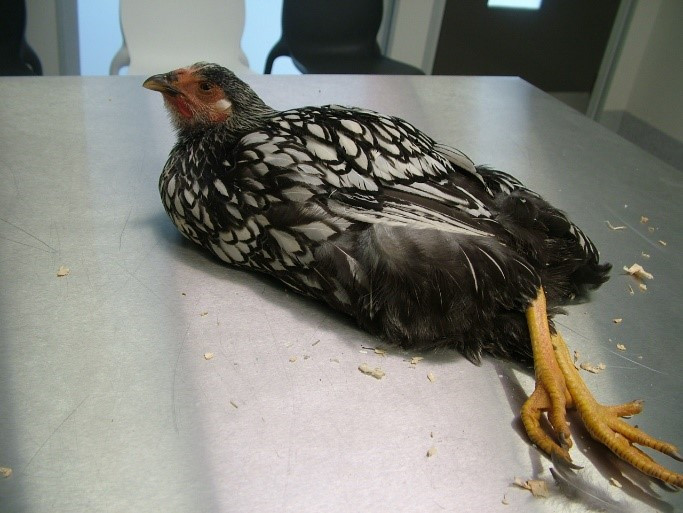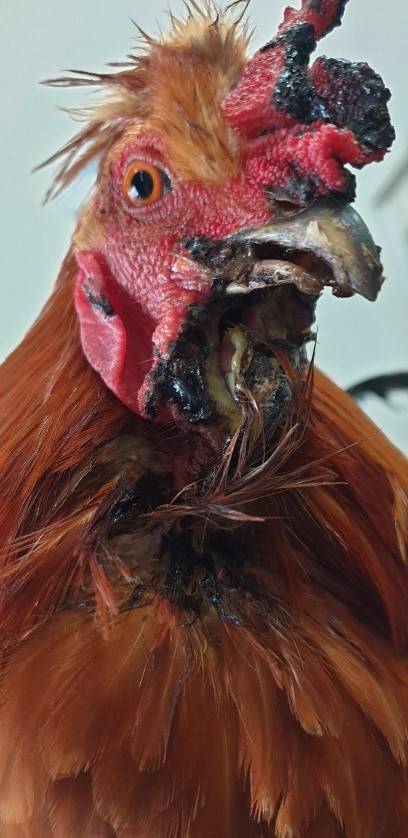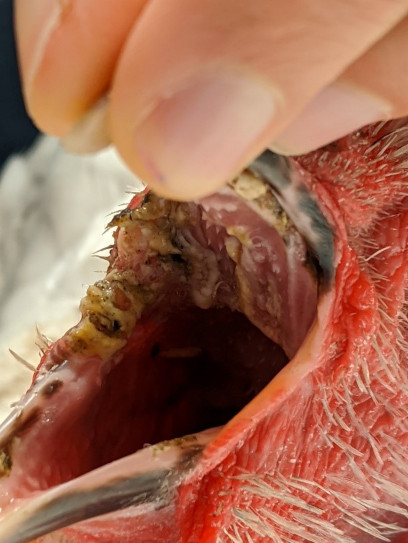What diseases can my chickens get?
As with the husbandry and management of any animal, there are disease problems associated with backyard chickens.
Understanding disease
We divide disease into two categories: non-infectious and infectious. Care must be taken not to confuse the words ‘infectious’ with ‘contagious.’ Infectious diseases are those caused by micro-organisms (viruses, bacteria, or fungi) or parasites; if the infection readily spreads from animal to animal it is said to be contagious. If a micro-organism is capable of causing disease in very low numbers, it is said to be highly infectious. If the infection spreads rapidly and easily between animals, it is said to be highly contagious. Understandably, it’s easy to confuse the terminology!
Non-infectious diseases are those not caused by micro-organisms or parasites e.g., cancer, heart disease, egg binding, trauma, etc.
Infectious and non-infectious disease may act at the same time in the same individual. Very few micro-organisms are primary pathogens i.e., capable of causing disease in an otherwise healthy individual. Most infectious diseases take advantage of an animal suffering from a non-infectious disease (or another infectious disease) and are said to be secondary pathogens.
As a rule, young chickens, with still-developing immune systems, are more likely to be affected with infectious diseases; as they age, they become more likely to develop non-infectious diseases.
Non-infectious diseases
Obesity is common in pet chickens fed ad lib (as much food as they want), especially with a lot of scraps and grain added to their diet. It can result in problems such as heart disease, liver disease, osteoarthritis, pododermatitis (bumblefoot), and even diabetes mellitus. Regular weighing of chickens, and control of their food intake in response, can help to prevent many of these problems.
Skin and feather problems are common in very fat chickens, but also in chickens fed on ‘homemade’ recipes (which are often nutritionally badly balanced). Feathers will become brittle and may not moult normally; the skin can become either very oily and very dry and flaky; nails can overgrow; and the leg scales can become very thick and painful.
Reproductive problems are common in chickens over the age of three years and can be seen in even younger birds. A large part of this due to genetic selection over the last 100 years for birds that grow rapidly, mature young, and lay eggs prolifically. Very few birds can maintain this pace year after year without ‘burn out’ and the result is a sharp rise on the incidence of reproductive problems after a few years of egg laying. These problems include:
- Egg binding – the hen is unable to lay her egg and becomes distressed as she tries to do so. Prompt veterinary care is needed to achieve a good outcome.
- Yolk peritonitis occurs when the chicken’s ovary ovulates, but the yolk fails to pass down into the uterus. Instead, it falls loose into the body, triggering an intense inflammatory reaction that results in large volumes of fluid to accumulate. This makes the hen very unwell, and, without treatment, she will die. Treatment is surgery to remove the fluid, yolks, and the often-diseased uterus.
- Pyometra literally means ‘pus in the uterus’. Pus in this case does not necessarily mean there is an infection – in fact, it is often sterile. But inflammation in the lining of the uterus results in thick caseous (cheese-like) pus filling the uterus. This, in turn, can lead to yolk peritonitis. Again, the treatment is surgical – the uterus must be removed, and the belly cleaned out.
- Ovarian and uterine cancer is sadly quite common in older chickens. Some is due to previous viral infections (see Marek’s Disease below) but in other cases the cause is often not known. By the time it is diagnosed, these cancers have often spread to other organs and all through the lining of the body, making treatment impossible.
Trauma is all too common in chickens, with dog bites a big problem that are difficult to manage because of the extensive damage inflicted when the dog grabs a chicken and shakes the bird savagely. This is not the only traumatic injuries that can occur – broken legs can occur when owners trip over a pet chicken and wings that were caught in doors can get broken.
Poisoning is less common these days, but occasionally occurs. Organophosphate washes such as malathion or maldison, especially if mixed too strongly or when out of date, are extremely toxic – diarrhoea, salivation, and seizures are the result. Ionophores are added to chicken starter diets to prevent coccidiosis, but are toxic to turkeys, peacocks, and waterfowl. So, if you have any chicken starter food be aware of this and make sure that no turkeys, peacocks, or waterfowl can access it. Pet chickens, especially in cities, are occasionally presented to vets with lead poisoning. The presence of lead in the blood and eggs of hens has particularly been associated with the presence of lead in old paint (prior to lead use in paints being phased out) on the property where the hens live. It is thought that hens may ingest lead from old paint flakes, paint dust in the soil, and even from lead that has accumulated inside earthworms and insects which the hens eat when free foraging.
Infectious diseases
As mentioned above, infectious diseases are those caused by viruses, bacteria, fungi, and parasites. Some of the more common infectious diseases seen in backyard poultry include Marek’s Disease, Fowl Pox, respiratory infections, bumblefoot, aspergillosis, ringworm, lice, mites, and intestinal parasites.
Marek’s Disease: This is one of the most common viral infections seen in chickens around the world. Caused by a herpesvirus, it is spread through the air and is so common it is assumed that chickens are exposed from the time they hatch. It is most common in young chickens, aged under four months, but can occur sporadically in older birds. Only chickens are affected by this virus. Infection causes a cancer of white blood cells most commonly in nervous tissue but also in the spleen, liver, and even the eye. The result is paralysis of the legs and wings, painful eyes, a swollen liver or spleen, and a crop that doesn’t empty. Not all chickens will show all these signs, but leg paralysis is the most common problem.

A chicken affected by leg paralysis due to Marek’s Disease.
There is no successful treatment for this disease, so prevention is the key.
Fowl Pox: This is a poxvirus infection that is also common in chickens. The virus is extremely stable in the environment (so it stays in the environment and can be infectious for years and is spread by fighting feather picking or, most commonly, by biting insects such as mosquitoes and flies. There are two forms of the disease. The most common takes the form of dry scabs and swellings on bare skin (the comb, wattles, eyes, and eyelids. The other, less common, form is known as diphtheritic or wet pox because of the yellow plaques of pus that form in the throat and mouth and can obstruct eating and even breathing.

The dry form of Fowl Pox– scabby sores over the facial skin, combs, and wattles.

The wet form of Fowl Pox– plaques at the back of the throat which make breathing and eating difficult.
As with nearly all viral diseases there is no cure for Fowl Pox. Fortunately, the infection is self-limiting i.e., the lesions will heal by themselves over 3-6 weeks, leaving the chicken immune for the next 6-12 months. Occasionally the lesions will develop a secondary bacterial infection and require antibiotics, but owners must resist the temptation to pull the scabs off, especially on the eyelids. This will often result in scarring and deformity.
Prevention is again the key. During spring and summer insect-proofing should be considered for poultry runs. Vaccination can be used in an outbreak, but the vaccination reaction may affect egg laying in birds older than 18 weeks.
Respiratory infections: Chickens are very commonly affected by upper respiratory tract infections, characterised by swollen sinuses, watery eyes, sneezing and coughing, and decreased egg production. Left untreated, the chicken can deteriorate, stop eating, and eventually die. Although many bacteria can cause this infection, the most common infections are known as Chronic Respiratory Disease (CRD, caused by Mycoplasma), Infectious Coryza (caused by Avibacterium paragallinarum), and Fowl Cholera (caused by Pasteurella multocida). These infections are spread by rodents, insects, and through the air. Some, such as Coryza, spread slowly in a flock, while others can spread very rapidly. A less common disease is Infectious Laryngotracheitis (ILT, a herpesvirus infection). This causes severe inflammation of the trachea (windpipe) causing the bird to cough to an extent they may start coughing up blood.
Diagnosis used to be complicated but with the advent of DNA testing, this is much simpler. It is recommended to test, rather than just treat, affected birds – knowing what disease you are dealing with can help to predict what is going to happen in both the individual bird but also in the flock.
Although they can be treated with antibiotics, some birds will require surgery to removed caseous pus from the sinuses. Some birds are so badly affected that nothing helps, and these birds may have to be euthanased on welfare grounds.
ILT, in many states, is a notifiable disease (this means that if it is detected it must be reported to public health authorities.) because it can resemble Avian Influenza. Your vet will advise you of this if the disease is diagnosed in your birds.
Bumblefoot: Also known as pododermatitis, this is a bacterial infection in the sole of a bird’s foot. There are a few things that contribute to it starting – an overweight bird, a poor diet, bad perches, a dirty pen. The result is a thinning of the skin on the sole of the foot which may split or be punctured, allowing infection to enter the foot. Initially the bird is slightly lame but as the infection worsens it spreads up the tendon sheaths, into the joints of the foot, and eventually invades the bone.
Treatment is determined by how severe the infection is. Early cases may respond to improving the perches, cleaning the pen, and some basic foot care. More advanced cases may require antibiotics, bandaging, and even surgery. In severe cases, treatment can cure the infection but the chicken may be permanently crippled by the extensive damage to joints and bones. Early recognition of the problem and aggressive veterinary treatment is the only way to prevent this.
Bibliography
Cowie E, Gartrell BD (2018) Lead concentrations in the blood and eggs of backyard laying hens. N Z Vet J 0:1–19
Greenacre C (ed), Morishita T (ed) (2021) Backyard Poultry Medicine and Surgery: A Guide for Veterinary Practitioners. John Wiley & Sons, Inc.
Poland G (ed), Raftery A (ed) (2019) BSAVA Manual of Backyard Poultry Medicine and Surgery. British Small Animal Veterinary Association
RSPCA Australia believes that captive-bred wild animals should not be kept in a home environment or for companion purposes unless the species has been clearly identified as being suitable for this purpose. It is important that animals living in a home environment can live a good life. This means providing for their physical health and ensuring opportunities to fully express their individual interests and experience good welfare. Inadequate care and husbandry are reported to contribute to common and serious welfare compromises in many captive wild animals living in home environments. For more information see our policy.
The reality is, however, that captive-bred wild animals are kept in home environments despite sometimes not meeting these criteria (e.g., some reptile and bird species). Because of this, the RSPCA has produced these articles on the care and welfare of a variety of commonly kept captive-bred wild animals. The aim is to help people better understand their animals as individuals and provide them with care that keeps them healthy and provides opportunities for positive mental experiences as much as possible in captivity.
Wild animals must not be taken from the wild to be kept as companion animals (pets).
Was this article helpful?
This work is licensed under a Creative Commons Attribution-NonCommercial-NoDerivatives 4.0 International License.



